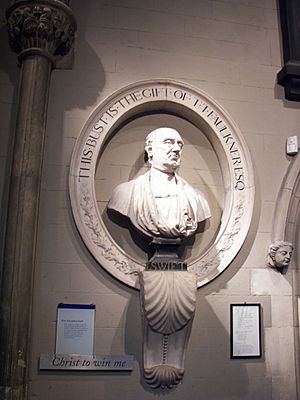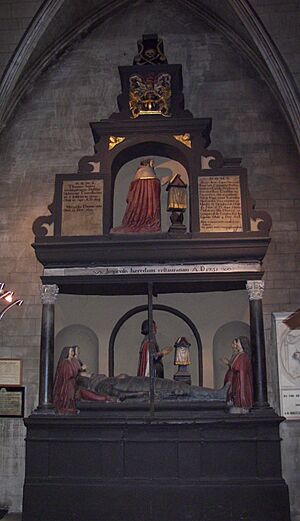Dean of St facts for kids


The Dean of St. Patrick's Cathedral is the main religious leader of St. Patrick's Cathedral in Dublin, Ireland. The cathedral's special group of clergy, called the chapter, chooses the Dean. This important job was created a long time ago, around 1219 or 1220, by Archbishop Henry de Loundres.
For many years, the Dean of St. Patrick's was the only Dean in Dublin. People often called him the "Dean of Dublin." But after about 1539, another Dean's job was created for Christ Church Cathedral.
Contents
How the Dean is Chosen
Who Elects the Dean?
Only the cathedral's chapter has the right to choose the Dean of St. Patrick's. This right has been strongly protected, even against kings, queens, and the Pope. For example, Jonathan Swift, who became a very famous Dean, was chosen even though Queen Anne didn't like him at all!
The Archbishop of Dublin is part of the chapter and has one of the 28 votes. However, the Archbishop doesn't have any other special power in choosing the Dean.
People Who Have Been Dean
Many people have served as Dean of St. Patrick's Cathedral over the centuries. Some of them held other important positions at the cathedral before becoming Dean.
Before the Reformation (Before 1537)
The Reformation was a big change in the Christian church in Europe. Before this time, the church in Ireland was part of the Roman Catholic Church.
- 1219-c.1238 – William FitzGuido, the very first Dean.
- c.1238-c.1250 – Richard Gardiner
- c.1250–1275 – Richard de St. Martin
- 1275–1284 – John de Sandford, who later became Archbishop of Dublin.
- 1284–1311 – Thomas de Chaddesworth
- 1311-c.1338 – William de Rodyard, who was also a judge.
- c.1338–1347 – Thomas de Montpellier, also a judge.
- 1347–1349 – Adan de Kingston
- 1349–1350 – Matthew Brissele
- 1350–1353 – John de Brienne
- 1353–1374 – William de Bromley, who held several important government jobs.
- 1374–1382 – John Colton, who was also Lord Chancellor of Ireland and later Archbishop of Armagh.
- 1382–1391 – Henry Bowett, who later became an Archbishop in England.
- 1396–1401 – Thomas de Everdon
- 1401-?1428 – John Prene, who later became Archbishop of Armagh.
- ?1428–1457 – Nicholas Hill
- 1457–1466 – Philip Norris
- 1466–1506 – John Alleyne
- 1506–1522 – Thomas Rochfort
- 1522–1527 – John Rycardes
- 1527–1528 – Robert Sutton
- 1528–1529 – Thomas Darcy
- 1529–1537 – Geoffrey Fyche
After the Reformation (1537 to 1870)
The Reformation brought big changes to the church in Ireland. St. Patrick's Cathedral was even closed for a few years between 1547 and 1555. It was then reopened.
- 1537–1547 – Edward Bassenet, chosen with pressure from the King.
- 1555–1560 – Thomas Leverous, appointed by Queen Mary. He later lost his job because he refused to agree with the new church rules.
- 1560–1565 – Alexander Craike
- 1565–1567 – Adam Loftus, who became Archbishop of Dublin and the first head of Trinity College, Dublin.
- 1567–1573 – Robert Weston, who was also a top judge.
- 1573–1581 – Sir William Gerard, another top judge.
- 1581–1585 – Thomas Jones, who later became Archbishop of Dublin.
- 1585–1597 – Richard Meredyth
- 1597–1608 – John Ryder
- 1608–1625 – Thomas Moigne
- 1625–1649 – Benjamin Culme
The office was empty from 1649 to 1660 during a time of political change in England and Ireland.
- 1660–1666 – William Fuller, who became a bishop and wrote a special song for the return of the King.
- 1666–1675 – Thomas Seele, who was also head of Trinity College, Dublin.
- 1675–1678 – Benjamin Parry
- 1678–1689 – John Worth
- 1689–1691 – William King, who became Archbishop of Dublin.
- 1691–1694 – Michael Jephson
- 1694–1696 – Thomas Lindsay, who became Archbishop of Armagh.
- 1696-1699- Edward Smyth
- 1699–1705 – Jerome Ryves
- 1705–1713 – John Sterne, who rebuilt the Dean's house.
- 1713–1745 – Jonathan Swift, the famous writer.
- 1745–1747 – Gabriel James Maturin
- 1747–1775 – Francis Corbet
- 1775–1794 – William Cradock
- 1794– Robert Fowler
- 1794–1810 – James Verschoyle
- 1810–1818 – John William Keatinge
- 1818–1828 – Richard Ponsonby
- 1828–1842 – Henry Richard Dawson, who helped fix up the cathedral building.
- 1842–1842 – Robert Daly
- 1843–1864 – Henry Pakenham
From 1846 to 1872, the job of Dean of Christ Church was also held by the Dean of St. Patrick's.
- 1864–1889 – John West
After Disestablishment (1870 to Present)
Disestablishment meant that the Church of Ireland was no longer the official state church.
- 1889–1901 – Henry Jellett
- 1902–1911 – John Henry Bernard, who later became Archbishop of Dublin and head of Trinity College, Dublin.
- 1911–1924 – Charles Thomas Ovenden
- 1924–1933 – Hugh Jackson Lawlor
- 1933–1935 – Thomas Arnold Harvey
- 1935–1950 – David Frederick Ruddell Wilson
- 1950–1968 – William Cecil De Pauley
- 1958–1968 – John Ward Armstrong, who later became Archbishop of Armagh.
- 1969–1991 – Victor Gilbert Benjamin Griffin
- 1991–1999 – Maurice Evan Stewart
- 1999–2012 – Robert MacCarthy
- 2012–2016 – Victor Stacey
- 2016-Present- William Morton

